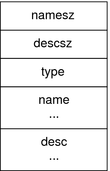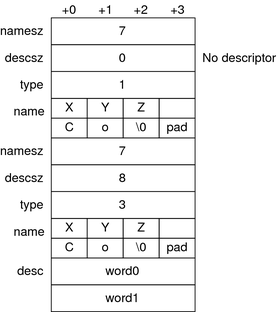| Skip Navigation Links | |
| Exit Print View | |

|
Oracle Solaris 11.1 Linkers and Libraries Guide Oracle Solaris 11.1 Information Library |
| Skip Navigation Links | |
| Exit Print View | |

|
Oracle Solaris 11.1 Linkers and Libraries Guide Oracle Solaris 11.1 Information Library |
Part I Using the Link-Editor and Runtime Linker
1. Introduction to the Oracle Solaris Link Editors
5. Link-Editor Quick Reference
7. Building Objects to Optimize System Performance
10. Establishing Dependencies with Dynamic String Tokens
Part IV ELF Application Binary Interface
64-bit SPARC: Relocation Types
Symbol Table Layout and Conventions
13. Program Loading and Dynamic Linking
A. Linker and Libraries Updates and New Features
A vendor or system engineer might need to mark an object file with special information that other programs can check for conformance or compatibility. Sections of type SHT_NOTE and program header elements of type PT_NOTE can be used for this purpose.
The note information in sections and program header elements holds any number of entries, as shown in the following figure. For 64–bit objects and 32–bit objects, each entry is an array of 4-byte words in the format of the target processor. Labels are shown in Figure 12-6 to help explain note information organization, but are not part of the specification.

The first namesz bytes in name contain a null-terminated character representation of the entry's owner or originator. No formal mechanism exists for avoiding name conflicts. By convention, vendors use their own name, such as “XYZ Computer Company,” as the identifier. If no name is present, namesz contains the value zero. Padding is present, if necessary, to ensure 4-byte alignment for the descriptor. Such padding is not included in namesz.
The first descsz bytes in desc hold the note descriptor. If no descriptor is present, descsz contains the value zero. Padding is present, if necessary, to ensure 4-byte alignment for the next note entry. Such padding is not included in descsz.
Provides the interpretation of the descriptor. Each originator controls its own types. Multiple interpretations of a single type value can exist. A program must recognize both the name and the type to understand a descriptor. Types currently must be nonnegative.
The note segment that is shown in the following figure holds two entries.
Figure 12-6 Example Note Segment
